In today’s competitive marketplace, effectively reaching your customers is paramount to business success. Among the myriad of marketing channels available, email marketing stands out as one of the most powerful and cost-effective tools. With its ability to deliver personalized content directly to your audience’s inbox, email marketing fosters meaningful connections and drives engagement. However, the true potential of email marketing is unlocked when combined with innovative strategies and advanced tools. Enter Prism Reach, an AI-powered SaaS solution designed to elevate your email marketing campaigns through deep personalization and sophisticated analytics.
Key Facts about Email Marketing
Email marketing continues to dominate as a preferred method for customer outreach. Here are some key facts and trends that highlight its effectiveness:
- High ROI: For every dollar spent on email marketing, businesses can expect an average return of $42.
- Personalization Matters: Personalized emails deliver six times higher transaction rates.
- Mobile Optimization: Over 50% of emails are opened on mobile devices, making responsive design crucial.
- Automation is Key: Automated email sequences can significantly enhance engagement and conversion rates.
Despite its advantages, many businesses face challenges in creating effective email campaigns. Common hurdles include list segmentation, content personalization, and optimizing send times. Leveraging advanced tools like Prism Reach can help overcome these obstacles, ensuring your email marketing efforts are both efficient and impactful.
Upgrade Your Email Marketing with AI Personalization!
Hidden Gems Strategies for Reaching Your Customers
To truly stand out in the crowded inbox, incorporating lesser-known but highly effective strategies can make a significant difference. Here are five hidden gems that can elevate your email marketing game:
Predictive Personalization
Predictive personalization uses AI and machine learning to anticipate customer needs and preferences. By analyzing past behaviors and trends, you can deliver hyper-personalized content and offers that resonate with each subscriber.
- How to Implement: Utilize AI-powered tools like Prism Reach to analyze subscriber data and predict future behaviors.
- Benefits: Increases relevance, boosts engagement rates, and enhances customer satisfaction.
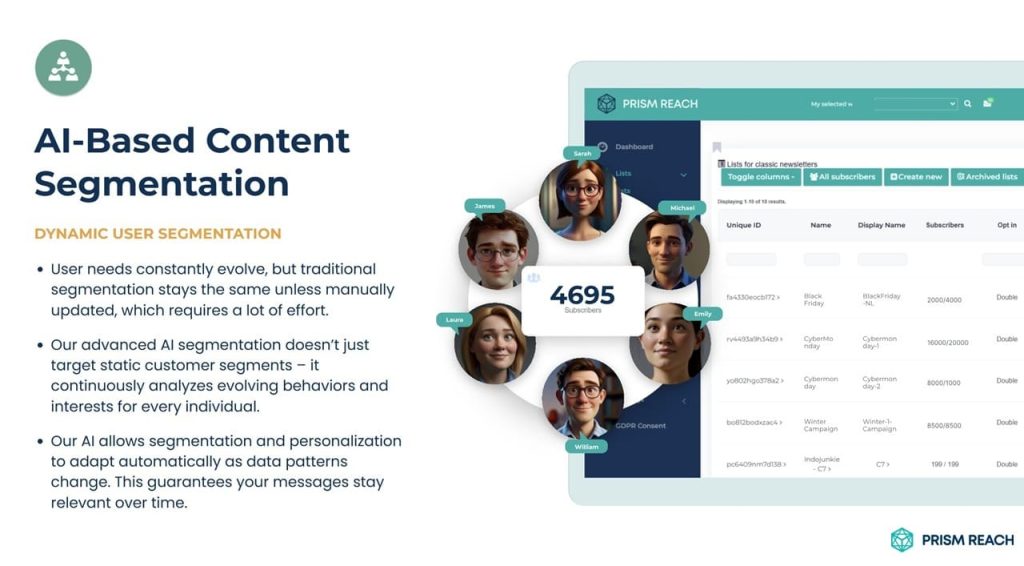
Micro-Moments Marketing
Micro-moments refer to the brief instances when customers turn to their devices for quick information or solutions. By targeting these specific moments with relevant content, you can capture their attention precisely when they need it.
- How to Implement: Create bite-sized, highly relevant email content that addresses common customer queries or needs.
- Benefits: Enhances timely engagement and increases the likelihood of conversions.
Behavioral Economics Principles
Applying principles from behavioral economics, such as anchoring, loss aversion, and the decoy effect, can subtly influence customer decision-making. These techniques can be woven into your email content to guide subscribers toward desired actions.
- How to Implement: Design your email layouts and offers to leverage these psychological triggers.
- Benefits: Drives higher conversion rates and encourages desired customer behaviors.
Ephemeral Content for Exclusivity
Ephemeral content, like time-sensitive offers or limited-time discounts, creates a sense of urgency and exclusivity. By integrating this into your email campaigns, you can prompt immediate action from your subscribers.
- How to Implement: Include exclusive, time-limited offers in your emails to encourage quick engagement.
- Benefits: Generates FOMO (Fear of Missing Out), leading to higher open and click-through rates.
Micro-Influencer Collaborations
Partnering with micro-influencers—individuals with smaller but highly engaged followings—can lead to more authentic connections and higher conversion rates. These collaborations can be seamlessly integrated into your email campaigns.
- How to Implement: Feature endorsements or content from relevant micro-influencers in your newsletters.
- Benefits: Enhances credibility and broadens your reach within niche audiences.
Maximizing Email Marketing with Prism Reach
Prism Reach is designed to amplify your email marketing efforts by providing advanced personalization and insightful analytics. Here are three key benefits of using Prism Reach in your email marketing strategy:
Enhanced Personalization
Prism Reach leverages AI to create detailed user avatars, allowing for highly personalized email content. By tailoring newsletters based on subscriber behavior, location, and preferences, your emails become more relevant and engaging.
Increased Engagement Rates
With features like AI-generated content suggestions and optimal sending times, Prism Reach ensures that your emails not only reach your audience but also resonate with them. This leads to higher open and click-through rates, driving better overall engagement.
Improved Productivity
Prism Reach’s seamless setup and automation capabilities reduce the time and effort required to manage email campaigns. Features like one-click uploads and automated workflow setups allow you to focus more on strategy and less on manual tasks.
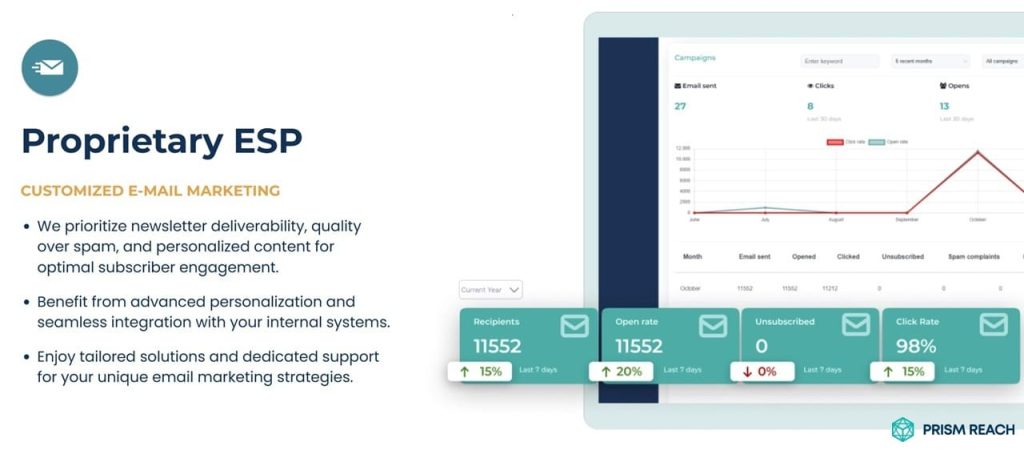
Practical Tips for Effective Email Marketing
Implementing the right strategies is crucial, but pairing them with practical tips can enhance their effectiveness. Here are some actionable tips to optimize your email marketing campaigns:
Segment Your Audience
Dividing your email list into specific segments based on demographics, behavior, or preferences allows for more targeted and relevant communications.
- How to Segment: Use data analytics tools like Prism Reach to identify key segments within your audience.
- Benefits: Increases relevance and engagement by addressing specific needs and interests.
Design Compelling Content
Your email content should be visually appealing and provide value to the reader. Incorporate a mix of text, images, and interactive elements to keep subscribers engaged.
- Tips: Use clear and concise language, include strong calls-to-action, and ensure mobile responsiveness.
- Benefits: Enhances readability and encourages desired actions, such as clicks and conversions.
Optimize Send Times and Frequency
Sending emails at the right time and frequency can significantly impact engagement rates. Utilize data-driven insights to determine the optimal times to reach your audience.
- How to Optimize: Use tools like Prism Reach’s predictive analytics to identify the best send times for different segments.
- Benefits: Maximizes open rates and minimizes unsubscribes by respecting subscriber preferences.
Leverage Automation and AI Tools
Automation can streamline your email marketing efforts, allowing for timely and relevant communications without manual intervention.
- How to Leverage: Implement automated email sequences for welcome messages, abandoned cart reminders, and post-purchase follow-ups using Prism Reach.
- Benefits: Saves time, ensures consistency, and enhances the overall customer experience.
Measuring Success and Refining Strategies
Tracking and analyzing the performance of your email marketing campaigns is essential for continuous improvement. Understanding which strategies are working and where adjustments are needed ensures that your efforts remain effective and aligned with your business goals. Prism Reach offers robust analytics tools that provide deep insights into your campaign’s effectiveness, enabling data-driven decision-making.
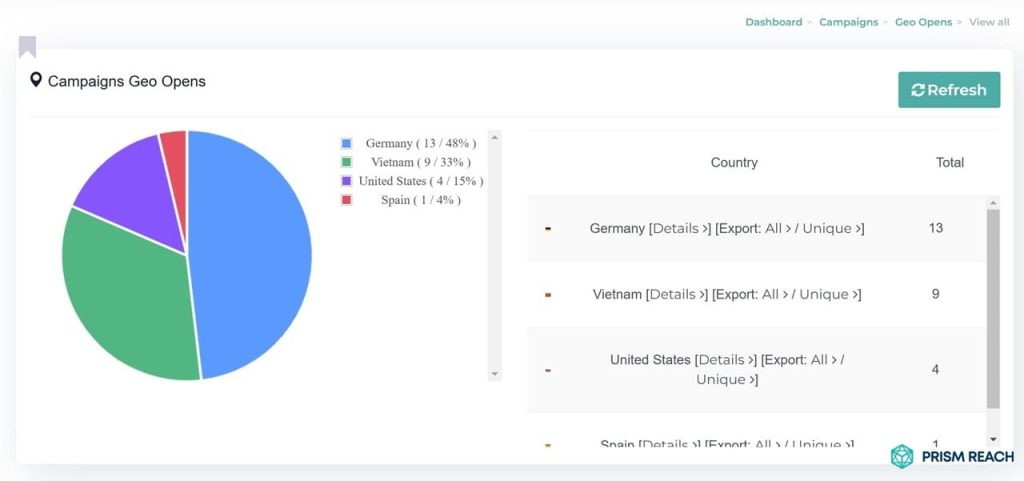
Key Metrics to Track
To measure the success of your email marketing campaigns, it’s crucial to monitor a variety of metrics that provide both quantitative and qualitative insights:
- Open Rates: This metric measures the percentage of recipients who open your emails. A higher open rate indicates that your subject lines are compelling and that your emails are reaching the inbox effectively.
- Click-Through Rates (CTR): CTR tracks the number of clicks on links within your emails. This metric helps you understand how engaging your content is and whether it prompts subscribers to take action.
- Conversion Rates: Conversion rates assess the percentage of recipients who complete desired actions, such as making a purchase or signing up for a webinar. This metric directly ties your email efforts to business outcomes.
- Customer Acquisition Cost (CAC): CAC calculates the cost associated with acquiring a new customer through your email campaigns. Lower CAC indicates more efficient marketing spend.
- Customer Lifetime Value (CLV): CLV estimates the total value a customer brings over their entire relationship with your business. Understanding CLV helps in tailoring long-term engagement strategies.
- Net Promoter Score (NPS): NPS gauges customer satisfaction and loyalty by measuring the likelihood of customers recommending your brand to others. A higher NPS indicates stronger customer advocacy.
- Bounce Rates: This metric tracks the percentage of emails that could not be delivered. High bounce rates can affect your sender reputation and email deliverability.
- Unsubscribe Rates: Monitoring unsubscribe rates helps you understand if your content is meeting subscriber expectations or if adjustments are needed.
- Engagement Over Time: Tracking how engagement metrics change over time can reveal trends and the long-term effectiveness of your email strategies.
Using Prism Reach’s Analytics Tools
Prism Reach provides comprehensive analytics that help you understand how your emails are performing and where improvements can be made. Here’s how you can leverage Prism Reach’s advanced features to measure and enhance your email marketing success:
- Audience Insights: Gain a clear view of user activity times and preferences to optimize your campaigns. By analyzing when your audience is most active, you can schedule emails to be sent at times when they are more likely to engage.
- Engagement Funnel: Visualize the customer journey from email open to conversion, identifying key drop-off points. Understanding where subscribers lose interest allows you to refine your content and calls-to-action to keep them moving through the funnel.
- A/B Test Results: Compare different email elements, such as subject lines, content layouts, and call-to-action buttons, to determine what resonates best with your audience. Prism Reach’s A/B testing tools provide clear insights into which variations perform better, enabling you to optimize future campaigns.
- Heatmaps: Utilize heatmaps to see where recipients are clicking within your emails. This visual representation helps you understand which parts of your email are most engaging and which areas may need improvement.
- Real-Time Analytics: Access live data on how your emails are performing in real-time. This allows you to make quick adjustments to ongoing campaigns, maximizing their effectiveness while they are still active.
- Conversion Tracking: Monitor the exact actions subscribers take after clicking through your emails. By linking email interactions to specific conversions, you can better understand the direct impact of your email campaigns on your business goals.
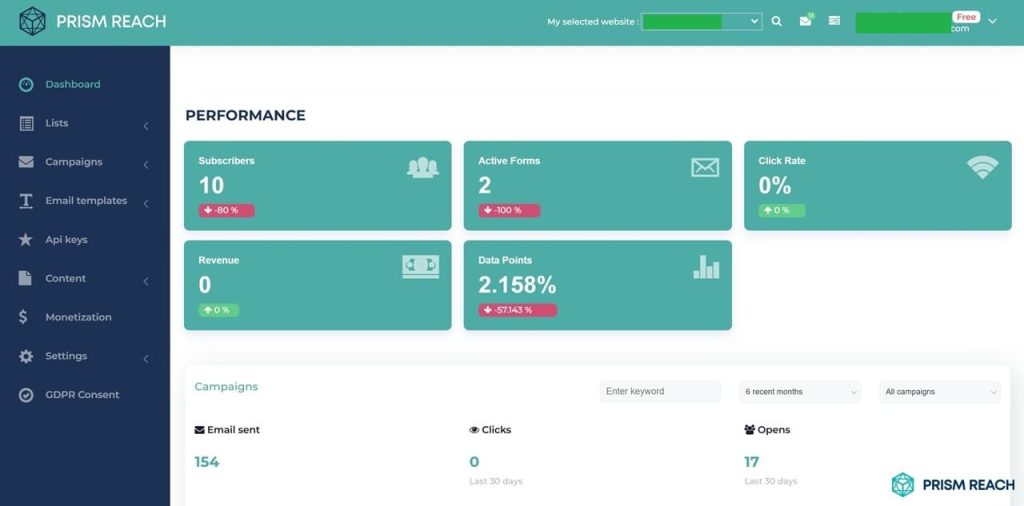
Step-by-Step Guide to Refining Your Strategies with Prism Reach
Refining your email marketing strategies is an ongoing process that involves analyzing data, testing new approaches, and iterating based on insights. Here’s a step-by-step guide on how to effectively use Prism Reach to refine your strategies:
Analyze Current Performance
- Review Key Metrics: Start by examining your current open rates, CTRs, conversion rates, and other key metrics using Prism Reach’s dashboard.
- Identify Trends: Look for patterns in your data, such as times when engagement is highest or types of content that perform well.
- Spot Weaknesses: Identify areas where your campaigns are underperforming, such as low open rates or high unsubscribe rates.
Set Clear Objectives
- Define Goals: Based on your analysis, set specific, measurable goals for your email campaigns, such as increasing open rates by 10% or reducing CAC by 15%.
- Align with Business Goals: Ensure that your email marketing objectives support your broader business goals, such as boosting sales or enhancing customer loyalty.
Implement A/B Testing
- Create Variations: Develop different versions of your emails, changing one element at a time (e.g., subject line, CTA placement).
- Run Tests: Use Prism Reach’s A/B testing tools to send variations to different segments of your audience.
- Analyze Results: Determine which variation performs better based on your key metrics and implement the winning version in future campaigns.
Optimize Content and Design
- Enhance Visuals: Use Prism Reach’s content suggestions to incorporate more engaging visuals, such as images and videos, into your emails.
- Improve Copy: Refine your email copy to be more compelling and aligned with your audience’s interests, leveraging Prism Reach’s AI-generated content ideas.
- Ensure Mobile Responsiveness: Use Prism Reach’s mobile preview features to ensure your emails look great on all devices.
Personalize Further
- Deepen Personalization: Use the detailed user avatars created by Prism Reach to tailor content even more precisely to individual subscriber preferences.
- Dynamic Content Blocks: Incorporate dynamic content that changes based on subscriber behavior and preferences, ensuring each email feels unique and relevant.
Automate and Streamline
- Set Up Automated Sequences: Create automated email sequences for different customer journeys, such as welcome series, re-engagement campaigns, and post-purchase follow-ups using Prism Reach’s workflow tools.
- Monitor Performance: Continuously track the performance of automated sequences and make adjustments as needed to improve outcomes.
Gather and Act on Feedback
- Collect Feedback: Use Prism Reach’s integration with survey tools to gather direct feedback from your subscribers about your email content and campaigns.
- Implement Changes: Analyze the feedback to identify areas for improvement and implement changes to better meet your subscribers’ needs.
- Close the Loop: Communicate back to your subscribers about the changes you’ve made based on their feedback, fostering a sense of community and trust.
Continuously Iterate
- Regular Reviews: Schedule regular reviews of your email marketing performance using Prism Reach’s analytics to stay on top of trends and shifts in subscriber behavior.
- Stay Updated: Keep abreast of the latest email marketing trends and best practices, integrating new strategies into your campaigns as appropriate.
- Experiment: Don’t be afraid to try new approaches and tactics. Use Prism Reach’s flexibility to test innovative ideas and incorporate successful ones into your standard practices.
Advanced Techniques for Measuring Success
Beyond basic metrics, there are advanced techniques that can provide deeper insights into your email marketing performance:
- Lifetime Engagement Tracking: Monitor how individual subscribers engage with your emails over their lifetime, identifying long-term trends and behaviors.
- Attribution Modeling: Use attribution models to understand how different touchpoints in your email campaigns contribute to conversions and sales.
- Predictive Analytics: Leverage Prism Reach’s predictive analytics to forecast future engagement and conversion trends, allowing for proactive strategy adjustments.
Incorporating Customer Feedback
Beyond quantitative metrics, qualitative feedback provides invaluable insights into customer preferences and pain points. Understanding the ‘why’ behind customer behaviors can guide more informed and effective strategy adjustments.
- Methods to Collect Feedback: Use surveys, social media polls, and direct conversations to gather customer opinions. Prism Reach’s integration with various feedback tools makes this process seamless.
- Analyze Feedback: Categorize and prioritize feedback to identify common themes and areas needing improvement. Use Prism Reach’s analytics to correlate feedback with engagement metrics.
- Implement Changes: Based on the feedback analysis, make necessary adjustments to your email content, design, and strategies. This could involve tweaking your tone, adjusting your content topics, or changing your send times.
- Communicate Back: Let your subscribers know that their feedback has been heard and acted upon. This can be done through follow-up emails or updates in your newsletters, fostering a sense of community and trust.
FAQ
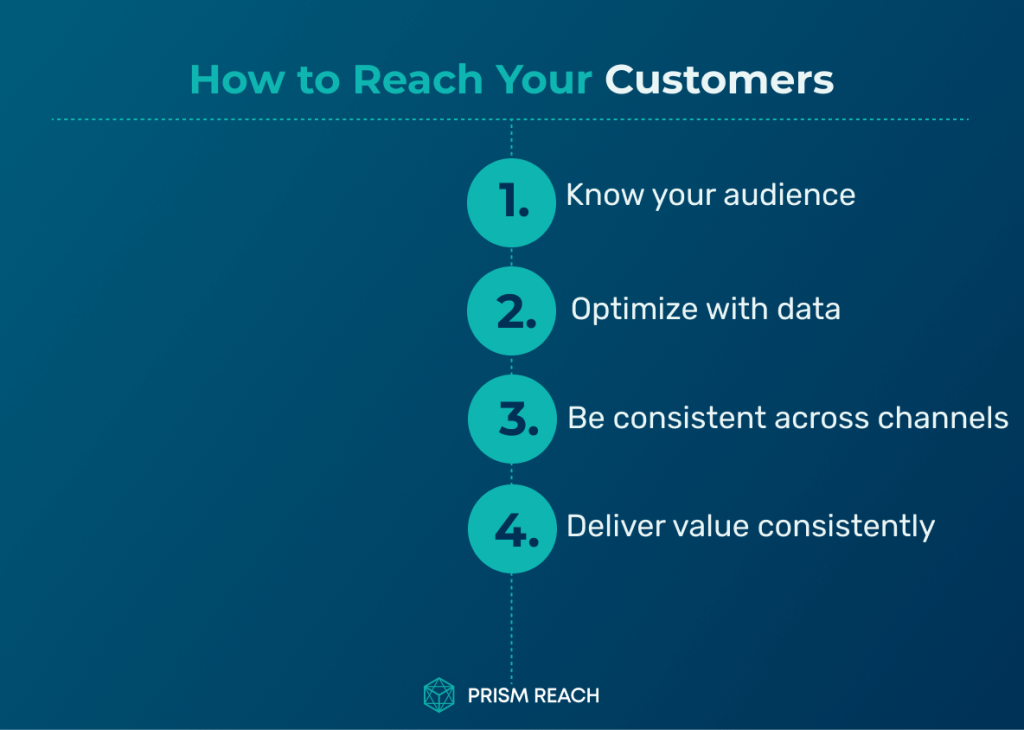
Conclusion
Reaching and engaging customers effectively requires a dynamic, multifaceted approach. By integrating innovative strategies like predictive personalization, micro-moments marketing, and leveraging behavioral economics principles, you can enhance the impact of your email marketing campaigns. Tools like Prism Reach play a crucial role in this process, offering advanced AI-powered features that streamline personalization, boost engagement, and improve overall productivity.
Remember, successful email marketing is not just about sending emails; it’s about building lasting relationships with your audience. By focusing on delivering value, personalizing content, and continuously refining your strategies based on data and feedback, you can create a loyal customer base that supports and advocates for your brand.
Embrace the power of AI-driven tools like Prism Reach to take your email marketing to the next level. With its ability to tailor content to individual preferences and provide actionable insights, Prism Reach ensures your messages resonate with each subscriber, leading to higher open rates, click-through rates, and ultimately, stronger customer relationships.
As we move forward in this ever-evolving digital landscape, tools like Prism Reach will become increasingly crucial in maintaining effective communication with your audience. By combining the strategies we’ve discussed with the power of AI-driven personalization, you’ll be well-equipped to not just reach your customers, but to engage them in meaningful ways that drive long-term loyalty and business growth.
Interesting sources
- Top 10 New Customer Engagement Strategies – Insight7
- Dublin’s 10 Types of Innovation in Customer Engagement – EA Consulting
- Customer Engagement Ideas – Userpilot
- Customer Engagement Ideas – Storyly
- Innovative Customer Engagement Examples – GoCustomer